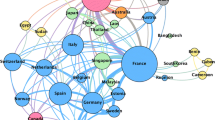Abstract
Collaboration and cross-disciplinarity are important features in autoimmune disease research. Taking co-authorship as an indicator for research collaboration, for selected European countries it was found that 91% to 99% of all publications are based on collaboration. International collaboration affects about 27% of all publications. Small countries like Sweden and Finland pursue international collaboration more intensively than larger countries like Germany or the UK. Different collaboration strategies were found for nationally co-authored papers, for instance, Germany seems to focus more on intra-departmental collaboration, while France and Italy have stronger inter-institutional links. About 54% of all publications are based on cross-disciplinary
Similar content being viewed by others
References
CERI,Interdisciplinarity. Problems of teaching and research in universities, OECD 1972.
Rossini, F. A., Porter, A. L., Interdisciplinarity research: performance and policy issue, In:R. Jurkovich, J. H. P. Paelinck (Eds)Problems in interdisciplinary Studies, 27–45. Vermont, Glower, 1984.
Porter, A. L., Chubin, D. E., An indicator of cross-disciplinary research,Scientometrics, 8 (1985) 161–176.
Cameron, H. M., Georghiou, L. G., Interdisciplinarity in the cognitive sciences and human computer interaction initiative,Research Evaluation, 3 (1993) 95–105.
Gibbons, M., Limoges, C., Nowotny, H., Schwartzman, S., Scott, P., Trow, M.,The New Production of Knowledge: Dynamics of Science and Research in Contemporary Societies, Sage Publications, London, Thousand Oaks, New Delhi, 1994.
Grupp, H., Schmoch, U., At the crossroads in laser medicine and polyimide chemistry—Patent assessment of the expansion of knowledge, In:H. Grupp (Ed.),Dynamics of Science-Based Innovation, Springer, Berlin, 1992a, 269–301.
Reger, G., Schmoch, U.,Organization of Science and Technology at the Watershed, Physica, Heidelberg, 1996.
Steinmann, L., Autoimmune diseases,Scientific American, 269 (1993) 74–83.
Hinze, S., Reiss, T., Schmoch, U., Strauss, E.,Statistical Analysis of Patents, Publications and External Trade in Sub-fields of Pharmaceuticals and New Materials, FhG-ISI, Karlsruhe, 1997.
Reiss, T., Hinze, S., Sandstroem, U., Tisell, A., Llerena, P., Matt, M., Trenti, S., Lemola, T., Palmberg, C..Case Studies on Autoimmune Diseases and Electrically Conducting Polymers, FhG-ISI, Karlsruhe, 1998.
Katz, J. S., Martin, B. R., What is research collaboration?Research Policy, 26 (1997) 1–18.
Bourke, P., Butler, L.,Discipline Boundaries in the Sciences and Social Sciences: An Old Problem Revisited, Paper presented at the Annual Meeting of the Society for Social Studies of Science (4S), Tuscon, USA, October 22–26, 1997.
Bourke, P., Butler, L., Institutions and the map of science: matching university departments and fields of research,Research Policy, 26 (1998) 711–718.
Carpenter, M. P., Cooper, M., Narin, F., Linkage between basic research literature and patents,Research Management, 13 (1980) 30–35.
Grupp, H., Schmoch, U.,Wissenschaftsbindung der Technik, Physica, Heidelberg, 1992b.
USPTO: http://patents.uspto.gov/
Peters, H. P. F., Braam, R. R., van Raan, A. F. J., Cognitive resemblance and citation relations in chemical engineering publications,JASIS, 46 (1995) 9–21.
Narin, F., Olivastro, D., Linkage between patents and papers: an interim EPO/US comparison,Scientometrics, 41 (1998) 51–59.
Luukkonen, T., Persson, O., Sivertsen, G., Understanding patterns of international scientific collaboration,Science, Technology and Human Values, 17 (1992) 101–126.
Author information
Authors and Affiliations
Additional information
The term ‘cross-disciplinarity’ is used to highlight the fact that contributions from more than one discipline are made and required. This more general term is used—rather than the term ‘interdisciplinarity’—because it collaboration, which was found to be even more important in international collaboration. is hard or even impossible to distinguish interdisciplinary from multi-disciplinary work based on the data used. For a more detailed discussion of the terminology see e.g. Refs 1–5.
Rights and permissions
About this article
Cite this article
Hinze, S. Collaboration and cross-disciplinarity in autoimmune diseases. Scientometrics 46, 457–471 (1999). https://doi.org/10.1007/BF02459604
Received:
Issue Date:
DOI: https://doi.org/10.1007/BF02459604




